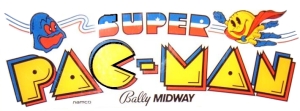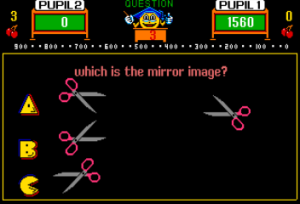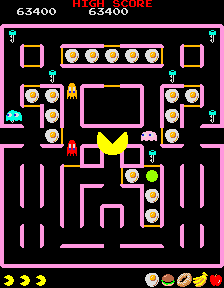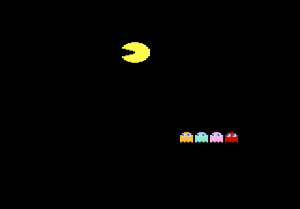Ahh, at last, a post that’s not about Ms. Pac-Man Turbo! Coming soon will be a pattern for the Super Pac-Man bonus mazes, but it’d be kind of awkward to jump right into a Super Pac-Man pattern post without giving a bit of info about the game.
Now, think about something. Back during the height of Pac-Mania, numerous books, video game magazines, and even the inner sleeve of the Pac-Man Fever album included never-fail patterns to help players clear the Pac-Man mazes. And these patterns were virtually failure-free because, well, Pac-Man was a predictable game — such a predictable game that too many players found it to be too easy.
So what happened when Pac-Man got too predictable? Well, players grew bored with the game. This was a problem because women liked to play Pac-Man, which means that as Pac-Man was losing popularity, arcades were losing the female customer base. Bally Midway, who distributed the game in the Unites States, voiced its concerns to Namco in Japan. Of course, the forward-thinking folks in Japan told Midway that they were already working on a Pac-Man sequel.
What is it with video games with characters named “Otto”?
However, as time passed, this Pac-Man sequel was nowhere to be found. Meanwhile, General Computer Corporation (“GCC”) came out with Crazy Otto, which was a hacked Pac-Man machine. Pac-Man became a new character with legs, and the ghosts were transformed into goblins. The game play itself was the same: gobble up the dots while being chased by the goblins, and eating an energizer would make the goblins vulnerable to Crazy Otto. However, the game play was a bit more challenging and precluded the usefulness of complete patterns. Clearing levels would periodically change the maze. Most of the mazes had two sets of tunnels rather than one. The prizes, which in Pac-Man were stationary under the ghosts’ pen, would float around the maze, entering from one tunnel and leaving through another.
Does the description of Crazy Otto ring a bell? It should — Midway bought the rights to Crazy Otto from GCC and hacked the graphics again. The goblins went back to being the ghosts with whom we’re familiar, and, with Midway keeping in mind that they wanted to retain and grow their female player demographic, Crazy Otto was once again Pac-Man…with an eye, a beauty mark, lipstick, and a bow. On January 13, 1982, Midway released what was essentially a hack of a hack and called it Ms. Pac-Man.
The folks in Japan, however, were furious. Namco had not authorized such an, in their eyes, inferior sequel. As far as Namco was concerned, Ms. Pac-Man was essentially the same game as Pac-Man. A proper sequel, Namco said, needs to feature a different style of game play. However, Ms. Pac-Man was an instant smash, and to this day is one of the most popular and successful video games ever. (It was only recently that Namco finally officially acknowledged Ms. Pac-Man as part of the Pac-Man series; I guess the suits in Japan realized that you can’t argue with success.) This success led Midway to create more unauthorized Pac-Man sequels, including Jr. Pac-Man, Exciting New Pac-Man Plus, the disastrous Baby Pac-Man pinball/video game hybrid, the pinball machine Mr. & Mrs. Pac-Man, and the useless and awful Professor Pac-Man (see an earlier post for my review). Meanwhile, Namco had also produced the authorized sequels Pac’n’Pal (released in the United States as Pac-Man and Chomp-Chomp) and Pac-Land, but the stream of unauthorized games from Midway prompted Namco to revoke Midway’s distribution privileges, so the next authorized Pac-Man sequel, Pac-Mania, was distributed in the States by Atari.
This means that the first actual, authorized Pac-Man follow-up was actually Super Pac-Man, released in October 1982 in Japan; in North America, however, the long-awaited sequel didn’t appear until ten months after Ms. Pac-Man took arcades by storm. Despite Namco’s insistence that a sequel’s game play be different from that of the original, the premise of Super Pac-Man was familiar: ghosts chase Pac-Man around a maze while Pac-Man tries to clear it; and there are four energizers throughout that enable Pac-Man to eat the ghosts for scores of 200, 400, 800, and 1600 as each ghost is eaten. However, instead of dots, Pac-Man is now eating various food items, such as apples, hamburgers, or bananas.
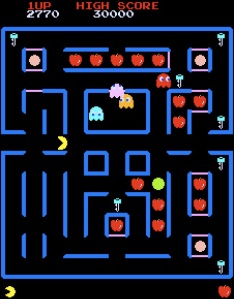
The first level of Super Pac-Man, after some apples have been eaten. Make sure both tunnel gates have been opened before you enter, or you could be in for a nasty surprise.
That’s not to say, though, that the game play is 100% the same as in Pac-Man. The food that Pac-Man has to eat is all behind locked gates. To access the foods, Pac-Man has to gobble up a key, giving him 50 points, and then a gate opens, allowing Pac-Man to enter and grab the food. (The later the level you’re on, the farther way the gate is that a given key unlocks.) In addition to energizers, each maze has two “Super Power Pellets,” which turn Pac-Man into Super Pac-Man, giving him special abilities and increasing his size significantly. While Pac-Man is “Super,” he moves a bit faster than Pac-Man, and if you want him to move even faster, hold down one of the “Super Speed” buttons on the ambidextrous control panel. Also while Pac-Man has his super powers, the ghosts appear stretched out, the assumption being that it’s how Super Pac-Man would see the ghosts as he flies over them at high speeds.) Super Pac-Man can also bust through locked gates for 200 points a pop.
As with Pac-Man and Ms. Pac-Man, a prize periodically appears, but once per level, and always stationary under the ghosts’ pen. The prize appears as a star after Pac-Man eats fifteen food items. Eat the star, and you get between 200 and 1600 points, depending on which level you’re on. While the star is on the screen, a food item appears on either side of the prize in enclosed boxes, and the food items rapidly change. If you eat the star when the food items are the same, you get 2000 points — or if said food items match and happen to correspond to the level (for example, if you’re on the apple level and both food items are apples), the award is 5000 points.
Periodically you’ll reach a bonus level, in which your maze is ghost-free and you have a limited time to clear it. If you clear the maze before time runs out, you’re given 100-point-per-clock-tick bonus with your remaining time. There are also occasional interstitial cut scenes as with the other Pac-Man games. As you progress in the game, the maze itself has the same exact layout, but the color changes as does the food item that Pac-Man will eat up. The food items’ point values increase with each level, starting at 10 points each for the apple level all the way up to 160 points each for wrapped gifts in later levels.
Super, sure, but…popular?
Super Pac-Man wasn’t exactly a runaway smash, which is a shame. It’s an interesting variation of the Pac-Man franchise. It can be pretty hard at times though; the difficulty setting, if at its most difficult, will allow almost zero time to devour any ghosts after Pac-Man eats an energizer. But you have some new strategies and twists, and even brand new players might not have any problem clearing the first maze.
However, despite its lack of popularity, Super Pac-Man did appear on several home systems, including Commodore 64, Nintendo Game Boy Color, and Sony PlayStation (as part of Namco Museum). Atari had made prototypes for its 8-bit line of computers as well as the Atari 5200; both prototypes have made the collectors’ rounds with dubious legality. Atari 7800 users are lucky enough to have a homebrew version, available for purchase on AtariAge.
Hey, want to play Super Pac-Man right now? Click here!
Next post will have my never-fail five-part pattern for clearing the bonus mazes before time runs out. In the mean time, do yourselves a favor and stay away from Black Friday “sales”!

